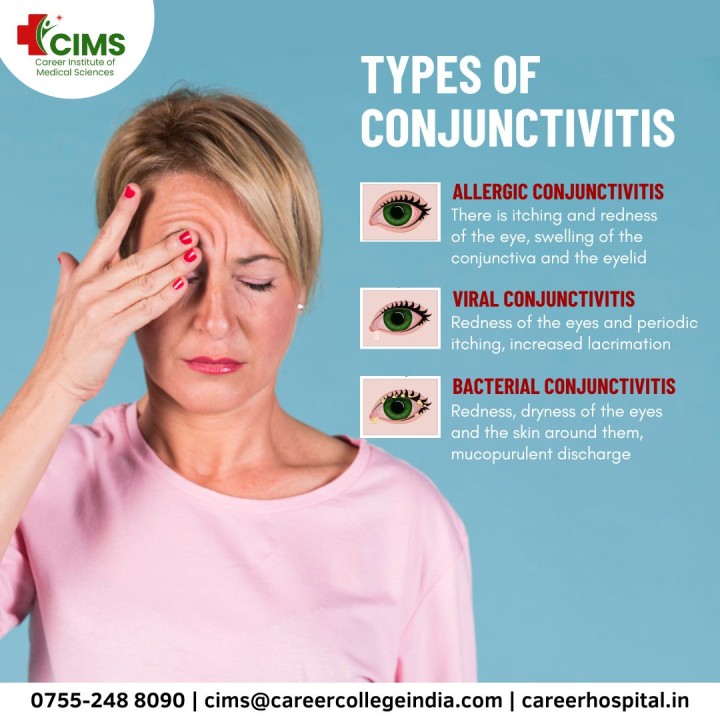
The Three Main Types of Conjunctivitis
Conjunctivitis is a common condition that occurs when either a viral or bacterial infection or an allergic reaction causes redness or inflammation in the conjunctiva — the clear tissue that covers the white part of your eye and the inside of your eyelids. Conjunctivitis is more commonly known as pink eye because it causes the white part of your eye to become pink or red.
Below, we explain the causes and symptoms of the different types of pink eye, when you should see an eye doctor, and what you can do at home to find some relief.
How Do You Get Pink Eye?
There are three main types of conjunctivitis: viral, bacterial, and allergic. However, conjunctivitis can also be caused by irritants, such as a foreign body in the eye, chemicals, or pollutants.
Viral Conjunctivitis
Viral infections cause nearly 80% of all conjunctivitis cases. Many different viruses, such as adenovirus, which typically leads to the common cold, can be the source of infection. Viral conjunctivitis spreads easily via touch from person to person, making outbreaks common among children in schools or daycare centers.
Although more rare, bacterial infections can also cause conjunctivitis. Types of bacteria that cause pink eye include:
- Staphylococcus aureus
- Streptococcus pneumoniae
- Haemophilus influenzae
- Moraxella catarrhalis
- Chlamydia trachomatis
- Neisseria gonorrhoeae
Bacterial conjunctivitis also spreads easily by touch, either through hand-to-eye contact or hand-to-nose contact. It can also thread through improper contact lens use.
According to the Centers for Disease Control (CDC) and Prevention, this type of pink eye is more common in adults than kids and occurs most frequently during the winter months (December through April).
When Should You See a Doctor for Pink Eye?
Most cases of pink eye do not require a doctor, as complications are rare. However, it is important to call your eye care provider should you have any questions, concerns, or experience the following issues:
- Pain or issues seeing
- Sensitivity to light
- Symptoms that do not improve after a week or get worse
- The eye keeps producing pus or mucus
- Fever or achiness
Eye doctors are specifically trained to treat these types of eye issues. We encourage patients to turn to an ophthalmologist or optometrist for treatment as these doctors are more likely to properly identify the cause of pink eye and provide correct treatment.
What to Do for Pink Eye at Home
There are steps you can take on your own to reduce symptoms of viral and bacterial conjunctivitis. Over-the-counter lubricating eye drops, in particular, can help with inflammation and eye dryness. Preservative free drops can be used as frequently as every hour to help cope with the itching and burning of the eyes and minimize the urge to rub them.
A cool, damp washcloth placed over your eyes can also soothe your eyes and loosen dried mucus or pus. Just be sure to use a clean washcloth each time to avoid spreading the infection.
If needed, ibuprofen or other nonsteroidal anti-inflammatory drugs (NSAIDs) can be used with caution and for a limited period to provide pain relief and reduce inflammation. (Topical NSAID drops should be avoided).
For allergic conjunctivitis, antihistamine medications (either oral or eye drops) are the most effective way to relieve symptoms at home. Many allergy medications can now be bought over-the-counter. Lubricating eye drops or a cool, damp washcloth may also provide relief for watery, itchy eyes.
As for what not to do at home, avoid using redness-reducing drops such as Clear Eyes or Visine. These drops contain a decongestant that temporarily reduces swelling in your eyes’ blood vessels. But, when you have an infection, redness-reducing drops may cause discomfort or make symptoms worse. When using artificial tears, those purchased in a bottle may contain preservatives that can worsen symptoms if used more than four to six times a day. If using lubricating tears, preservative-free options are gentler on the eye and may help more with symptom relief.
A study in the American Academy of Ophthalmology (AAO) Journal researched 300,000 cases of acute conjunctivitis and found 83% of patients were initially diagnosed by primary care providers instead of ophthalmologists or optometrists and that a majority of these patients were incorrectly prescribed antibiotics, which will not help with most cases of pink eye. In fact, the study also revealed antibiotic-steroid drops are not needed for most patients with acute conjunctivitis because they may prolong or exacerbate certain infections.
#Conjunctivitisinchildrens #Conjunctivitis #ConjunctivitisSymptoms #ConjunctivitisCauses #Conjunctivitistypes #CIMS #CareerHospital #CareerInstituteofMedicalSciences #NABH #Accreditedbynabh #healthcare #cancertreatment #cancerresearch #ctscan #neverbackdown #nevergiveup #cancer #BreastCance #Conjunctivitis #CareerHospitalinbhopal #CervicalCancer #Cervical
🌟 "The greatest wealth is health," as Virgil once said. It looks like you're shedding light on an important health issue many overlook! Keep spreading valuable info on #Conjunctivitis to help others stay informed and healthy! 💪💖 #HealthIsWealth